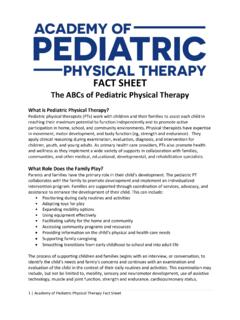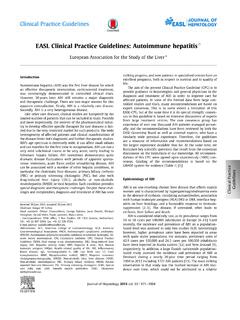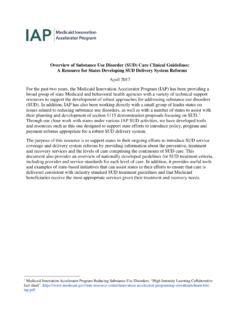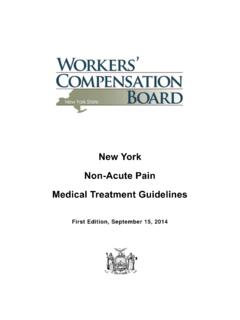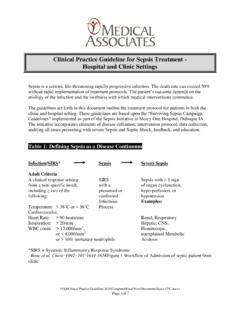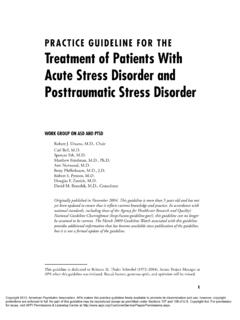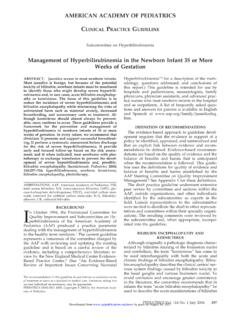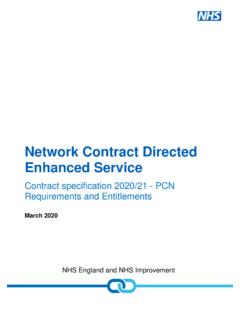Transcription of Clinical Practice Guidelines for the Management of Rotator ...
1 Clinical Practice Guidelines for the Management of Rotator Cuff Syndrome in the WorkplaceNever Stand StillMedicineRural Clinical SchoolThe University of New South Wales, Medicine, Rural Clinical School, Port Macquarie Campus 2013 The work was initiated and funded by Essential Energy, AustraliaCopyright: The University of New South Wales, Medicine, Rural Clinical School. 2013 ISBN Number: 978 0 7334 3195 5 Suggested Citation: Hopman K, Krahe L, Lukersmith S, McColl AR, & Vine K. 2013. Clinical Practice Guidelines for the Management of Rotator Cuff Syndrome in the University of New South document is available online at prepared by: Lukersmith & Associates Pty LtdEditor: Dr Lee Krahe, Louise Scahill - WordFix, Kris VineDesign: Melinda Jenner and Eva Wong, Print Post Plus (P3) Design StudioPrinting: Print Post Plus (P3) Clinical Practice Guidelines for the Management of Rotator Cuff Syndrome in the WorkplaceThe University of New South Wales, Medicine, Rural Clinical School, Port Macquarie Campus2013 Research Team.
2 Kate Hopman2, Lee Krahe1, Sue Lukersmith2, Alexander McColl1, Kris The University of New South Wales, Medicine, Rural Clinical School, Port Macquarie Campus 2 Lukersmith & Associates Pty LtdWorking Party MembersNameRoleOrganisationDr David AllenOccupational & Environmental PhysicianPrivate PracticeDr Roslyn AveryRehabilitation Physician Private PracticeMr Greg BlackConsumer RepresentativeSelf-Employed Trade IndustryMr Patrick FrancesConsumer Representative Volunteer WorkerMs Kate HopmanIndependent Guideline Development ExpertLukersmith & AssociatesDr Lee Krahe Head of ResearchPort Macquarie Campus, Rural Clinical School, UNSWDr Yong Hian LiawOrthopaedic Surgeon Port Macquarie Base Hospital and Private PracticeMs Sue LukersmithIndependent Guideline Development ExpertLukersmith & AssociatesDr AR (Sandy) McColl (Chairperson)General Practitioner, Head of CampusPrivate Practice Port Macquarie Campus, Rural Clinical School, UNSWDr Christopher NeedsRheumatologist Private PracticeRoyal North Shore HospitalMr Jeremy RourkePhysiotherapist Port Macquarie Base HospitalMr John ScullinPhysiotherapist Private PracticeMs Amy VallentineOccupational TherapistPrivate PracticeMs Kris VineResearch OfficerPort Macquarie Campus, Rural Clinical School, UNSWDr Stephen YoungGeneral PractitionerPrivate PracticeConflict of InterestThe funding body for this project, Essential Energy, has not been involved at any stage in the guideline development process, method, writing or review of the Guidelines .
3 As the Guidelines were developed in complete isolation of the funding body, their views or interests have not influenced the recommendations or the Guidelines . All individuals whose names appear as authors or contributors to these Clinical Practice Guidelines provided full written disclosure of any real or perceived conflict of interest prior to participating in the working party. Each person was obliged to report any real or perceived conflict of interest (should it have arisen) during the guideline development process. Acknowledgements We wish to thank the 12 organisations and individuals who reviewed and provided feedback on the Guidelines during their development. All comments received were discussed and considered by the research executive and incorporated into the final document where Executive Summary Flowcharts Introduction Background Scope and Purpose Framework Bio-psychosocial Perspective of Health and Functioning Approach Used in Guidelines Intended Users Related publications Rotator Cuff Syndrome Definition Incidence and Prevalence Prevention Prognosis Guidelines Development Working Party Method Initial Presentation Clinical History Physical Examination Identification of Red Flags Identification of Yellow Flags Limitations of Imaging in Early Presentations 284 Guidelines for Rotator Cuff Development of a Management Plan Treatment Principles Maintain
4 Activity and Participation in Life Areas Shared Decsision-making Goal Setting Outcome Measurement Collaborative Team Approach Cultural and Language Issues Treatment Pain Management Medication Heat/Ice Return to Work Program Prescribed Exercise Manual Therapy Acupuncture Electro-physical Agents Transcutaneous Electromagnetic Stimulation (TENS) Bipolar Interferential Current Pulsed Electromagnetic Field Therapy (PEMF) Low Level Laser Therapy (LLLT) Therapeutic Ultrasound Calcific Tendonitis Emerging Treatments Supplements Review Recovery Rotator Cuff Pathology Patient Experiencing Significant Persisting Pain and/or Activity Restriction Diagnostic Imaging Preferred Imaging for Rotator Cuff Syndrome Subacromial Injections of Corticosteroids Referral for Specialist Opinion Rotator Cuff Tears Rotator Cuff Surgery When should Surgery be Performed for Rotator Cuff Syndrome?
5 Recovery and Outcomes Following Rotator Cuff Surgery 51 Resources 53 Rotator Cuff Syndrome Information Sheet 55 General Practitioner Guide Return to Work 57 Employer Guide Return to Work 59 Flowchart: First Presentation Shoulder Pain 61 Flowchart: Review (Post 4 6 weeks) 63 Flowchart: Red Flags for Rotator Cuff Syndrome 65 Glossary 66 APPEnDIx 1 Red and Yellow Flags for Rotator Cuff Syndrome 67 APPEnDIx 2 Clinical Questions 68 APPEnDIx 3 nHMRC Evidence Hierarchy 70 APPEnDIx 4 International Classification of Diseases Codes 73 References 746 Guidelines for Rotator Cuff SyndromeTablesTable 1: NHMRC Grades for Recommendations 20 Table 2: Indicators Identified in the Clinical History to Assist Assessment and Differential Diagnosis 22 Table 3: Personal Factors that may Influence the Development of Shoulder Pain 23 Table 4: Environmental Factors that may Influence the Development of Shoulder Pain 24 Table 5.
6 Yellow Flags that may Influence Recovery and RTW Following Rotator Cuff Syndrome 26 Table 6: Best Practice Standards for Return to Work Approach 36 Table 7: Return To Work Intervention Best Practice Standards 38 Table 8: Factors that may Influence Recovery Following Rotator Cuff Surgery 51 FiguresFigure 1: Red Flags for Rotator Cuff Syndrome 14 Figure 2: The Rotator Cuff Normal Anatomy (a) and Post-Injury (bursa not shown) (b) 17 Figure 3: Return to Work Hierarchy 36 Text boxesText Box 1: Clinical Framework for the Delivery of Health Services 16 Text Box 2: Psychometric and utility properties of outcome measures 317 ForewordThe University of New South Wales Rural Clinical School, Port Macquarie has developed Guidelines for the Clinical Management of Rotator cuff syndrome in the workplace. Shoulder pain is a common musculoskeletal presentation in primary care Practice both degenerative and acute. As such, it provides a challenge to all involved in prevention and treatment, from patients to clinicians to primary objective of these Guidelines is to provide recommendations, based on current evidence, which will hopefully improve Clinical outcomes for workers, employers and health care providers.
7 These Guidelines have been developed through a review of previous Guidelines for the Management of musculoskeletal/ Rotator cuff syndrome and a systematic review and appraisal of all relevant literature from 2000 to the present. Methodology and tables of evidence may be found in the accompanying technical report. Clinical Practice Guidelines are bound by the same limitations as all research. As such, these Guidelines are offered to assist health care providers, workers and employers achieve the best outcome from Rotator cuff syndrome. Clinical Practice Guidelines inform and guide but do not replace Clinical reasoning or Clinical Guidelines utilise the framework provided by the International Classification of Functioning, Disability and Health a biopsychosocial model of health which considers medical, psychosocial and contextual factors with a focus on early return to work (RTW).These Guidelines were made possible by a grant from Essential Energy.
8 It is heartening to see industry as a prime mover in the creation of tools to prevent injury and assist workers return to full health and functional executive would like to acknowledge the work of Lukersmith and Associates Sue Lukersmith and Kate Hopman for their experience, expertise and guidance in this project. They worked tirelessly to provide up-to-date, evidence-based, well-appraised information which made this project executive would also like to acknowledge the valuable input of all members of our working party. Members of the working party gave of their time, Clinical experience and personal insight to contribute to this document. We also thank the members of the Expert Advisory Panel and peer reviewers who contributed to this , I must thank the other members of the research executive, Dr Lee Krahe and Ms Kris Vine. In addition to their contribution to the written document, their work behind the scenes to ensure the smooth completion of all technical and logistical hurdles was simply AR (Sandy) McColl Chairperson Clinical Practice Guidelines Working Party8 Guidelines for Rotator Cuff Syndrome9In developed countries, managing Rotator cuff syndrome in the workplace presents significant challenges for health care providers and industry employers.
9 Rotator cuff syndrome can substantially affect a person s health and functioning with pain and/or weakness often restricting a person s ability to carry out their daily activities and to work. Rotator cuff syndrome frequently results in lost productivity and significant financial costs for industry and employers. It is therefore imperative that appropriate evidence-based Management of Rotator cuff syndrome is adopted to minimise negative outcomes for individuals, their families and the workplace. The Guidelines have been developed using a rigorous methodology for searching, appraising and grading evidence. Recommendations have been developed using recent research evidence in conjunction with a multidisciplinary working party. Flowcharts and resources have been developed to support the use of the Guidelines . Resources include: Rotator cuff syndrome information sheet (for injured workers) and return to work (RTW) guides for employers and Guidelines are applicable to GPs, medical specialists and other health care providers involved in the treatment of people with Rotator cuff syndrome such as physiotherapists, occupational therapists, psychologists, ergonomists, chiropractors and osteopaths.
10 The Guidelines can also be used by the injured worker and both workplace-based employees and workers compensation insurers involved in coordinating and supporting the RTW for workers with Rotator cuff syndrome. Executive Summary10 Guidelines for Rotator Cuff FlowchartsFactors identified which may influence recovery and/or RTW (Appendix 1)Yellow FlagsRed FlagsYe sNoNoYe sOnwards referral as appropriateOnwards referral as appropriate (Figure 1)First Presentation Shoulder PainThorough History and Physical ExaminationRecommendations 11, 12 Prescribed exerciseand/or manual therapyand/or acupunctureRecommendations 13, 14 Recommendations 15 - 20 Recommendations 21 - 24 Recommendations 7 - 10 Recommendation 25 Recommendations 1 - 6 Initial Diagnosis of Rotator Cuff SyndromeDevelopment of Management PlanIncluding activity and work participationInitial TreatmentInjured Worker to be Reviewed by their Clinician in Two Weeks Earlier if no response to treatment or adverse treatment side effectsParacetamol For mild to moderate pain and/or NSAIDsHeat/ColdRTW Program11 Rotator Cuff Syndrome RecommendationsRecommendation 1.

